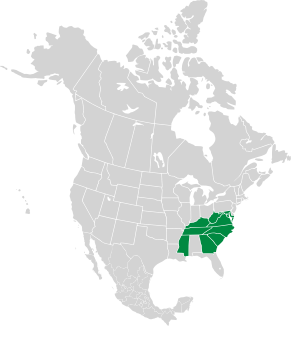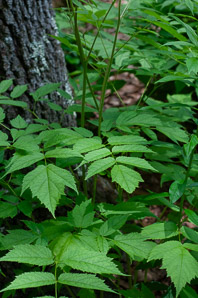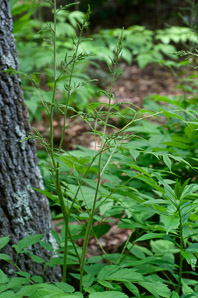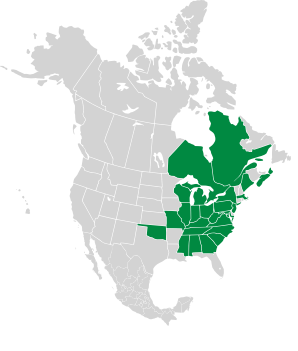
|
Astilbe biternata (Vent.) Britton False goatsbeard
False goatsbeard is so named because it bears an uncanny resemblance to “real” goatsbeard, Aruncus dioicus. Both names refer to the flower masses, whose shape somewhat resembles a goat’s beard. False goatsbeard is native to North America, and prefers shady habitats and damp soil. Plants: Plants are 2-6′ (60-182 cm) high, and dioecious, having separate male and female plants. Leaves: Bright green, coarse, up to 2′ (60 cm) long, bipinnate or tripinnate, with ovate leaflets. Leaflets are 3-6″ (8-15 cm) × 1½-6″ (4-15 cm). Leaf edges are toothed: sharply serrate to crenate. The terminal leaflet has three lobes. Flowers: Long, thin, feathery cream-colored or yellowish sprays of tiny florets, like white fireworks displays. Florets have 5 petals, and ten stamens. Blooms appear from late spring to early summer. Fruits: Fruits usually have two carpels, and are ~⅛″ (3.5-4 mm) in size. These species are closely similar, so much so that they are often cited as prime examples of convergent evolution. They prefer the same habitats and are often found growing side-by-side: |
5/22/2010 · Garden in the Woods, Framingham, Massachusetts · ≈ 2 × 1½′ (71 × 47 cm) 5/22/2010 · Garden in the Woods, Framingham, Massachusetts · ≈ 1 × 1½′ (34 × 52 cm) |
||||||||||||||||||||||||||||
|
| |||||||||||||||||||||||||||||
Aruncus dioicus var. dioicus |
You are here Astilbe biternata |
||||||||||||||||||||||||||||
|---|---|---|---|---|---|---|---|---|---|---|---|---|---|---|---|---|---|---|---|---|---|---|---|---|---|---|---|---|---|
| Common Name |  |
 |
|||||||||||||||||||||||||||
| Plant | In clumps several feet around. Thin, stiff stems support leaf clusters topped by showy sprays of white flowers. | 2-6′ (60-182 cm) high, and dioecious. | |||||||||||||||||||||||||||
| Flowers | Long, thin, feathery cream-colored sprays of tiny florets. Male flowers are somewhat more showy. Each floret has 15-20 stamens and 3-5 pistils. | Long, thin, feathery cream-colored or yellowish sprays of tiny florets, like white fireworks displays. Florets have 5 petals, and ten stamens. Blooms appear from late spring to early summer. | |||||||||||||||||||||||||||
| Leaves | Bipinnate or tripinnate, with 20 or more toothed (dentate), opposite, oval leaflets. Individual leaflets are 1-5″ (2.5-12 cm) long. | Bright green, coarse, up to 2′ (60 cm) long, bipinnate or tripinnate, with ovate leaflets. Leaflets are 3-6″ (8-15 cm) × 1½-6″ (4-15 cm). The terminal leaflet has three lobes. | |||||||||||||||||||||||||||
| Fruit | Female plants produce three carpels with tiny brown seed capsules. | Usually have two carpels, and are ~⅛″ (3.5-4 mm) in size. | |||||||||||||||||||||||||||
| Range/ Zones |
|
|
|||||||||||||||||||||||||||
| Habitats | Moist wooded areas, fields, roadsides, and waste areas. | Shady habitats and damp soil. | |||||||||||||||||||||||||||
| Type | Wild | Wild | |||||||||||||||||||||||||||
Online References:
The Lady Bird Johnson Wildflower Center
Wildflowers of the United States
Astilbe biternata description by Thomas H. Kent, last updated 25 May 2020.
© FloraFinder.org. All rights reserved.
Range: Zones 5-8:





